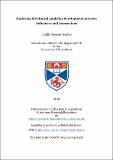Files in this item
Exploring the clinical guideline development process : influences and interactions
Item metadata
| dc.contributor.advisor | Jung, Tobias | |
| dc.contributor.advisor | Nutley, Sandra M. | |
| dc.contributor.author | Hughes, Judith Deborah | |
| dc.coverage.spatial | xx, 340 p. | en_US |
| dc.date.accessioned | 2019-08-07T10:16:28Z | |
| dc.date.available | 2019-08-07T10:16:28Z | |
| dc.date.issued | 2019-06-28 | |
| dc.identifier.uri | https://hdl.handle.net/10023/18260 | |
| dc.description.abstract | Evidence-based clinical guidelines serve as an important support for medical decision-making. To date, research on clinical guidelines has focused mainly on guideline development methodology and the extent of guideline implementation. How guideline groups utilise various forms of evidence and the social processes involved in developing clinical guidelines have not yet been fully explored. This qualitative study considers the individual, group and external factors that influenced the recommendations made by one guideline development group for the guideline concerning diagnosis and management of macular degeneration within the ophthalmology therapeutic area in the UK. Using direct observation, interviews and document analysis methods, this study explored, over 27-months, how the guideline group proceeded from reviewing the evidence on this condition to drafting guideline recommendations. This research provides a detailed account of how the guideline group – working within an environment that includes influential external stakeholders – interpreted evidence, interacted and functioned as a group, and made consensus decisions on guideline recommendations. The study reveals that the ready availability (and acceptability) of evidence shapes the extent of reliance on expert opinion. In circumstances of low evidence availability, expert opinion is relied upon and factors such as group composition and dynamics, resource availability and external network challenges appear to be particularly important in the guideline development process and in shaping the guideline recommendations. The study is the first to provide an account of the guideline development process in the ophthalmology area as well as adding, more generally, to the empirical literature on the clinical guideline development. The findings suggest that clinical and economic evidence does not easily or smoothly translate into strong recommendations. Rather, guideline development involves the interplay of many factors. An additional contribution of this research is the development of an integrative framework to capture and analyse these factors within the guideline development process. | en_US |
| dc.language.iso | en | en_US |
| dc.publisher | University of St Andrews | |
| dc.title | Exploring the clinical guideline development process : influences and interactions | en_US |
| dc.type | Thesis | en_US |
| dc.type.qualificationlevel | Doctoral | en_US |
| dc.type.qualificationname | PhD Doctor of Philosophy | en_US |
| dc.publisher.institution | The University of St Andrews | en_US |
| dc.rights.embargoreason | Embargo period has ended, thesis made available in accordance with University regulations | en |
| dc.identifier.doi | https://doi.org/10.17630/10023-18260 |
This item appears in the following Collection(s)
Items in the St Andrews Research Repository are protected by copyright, with all rights reserved, unless otherwise indicated.

